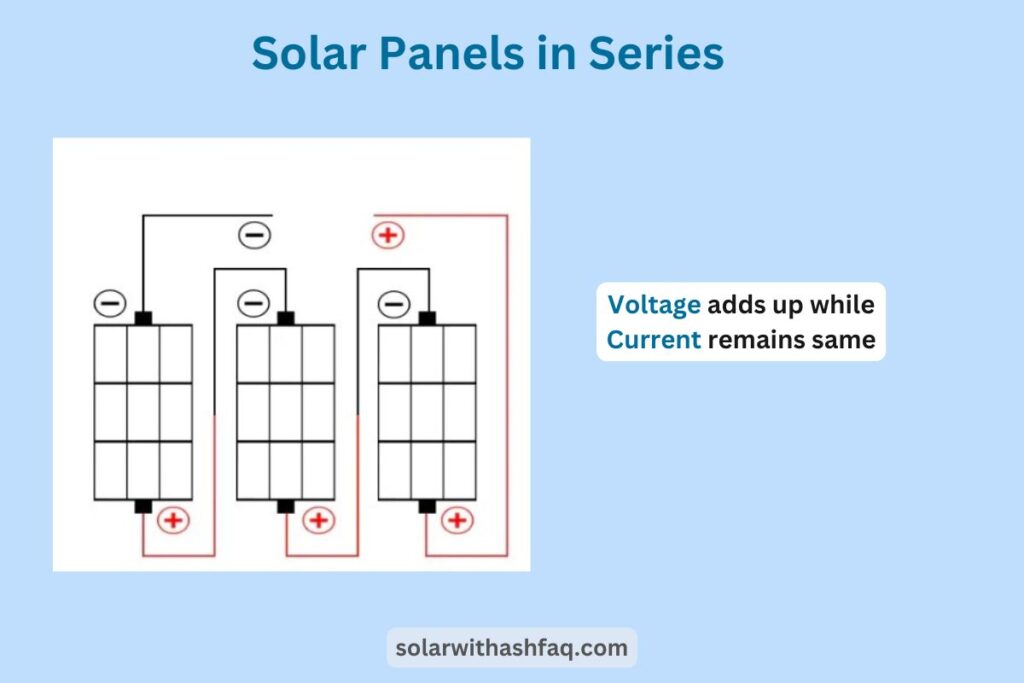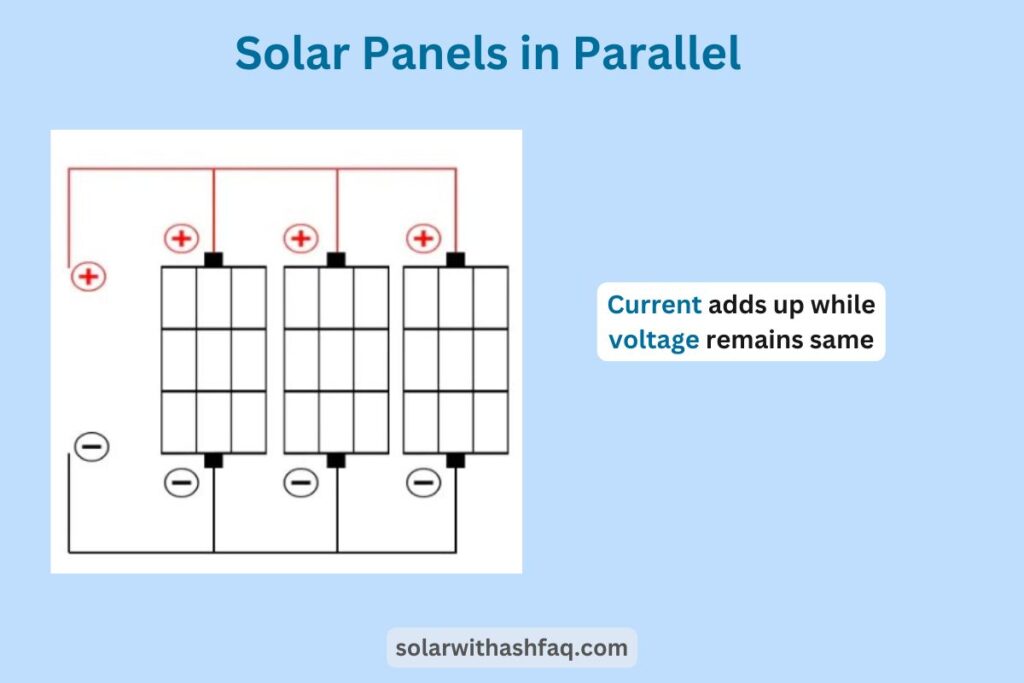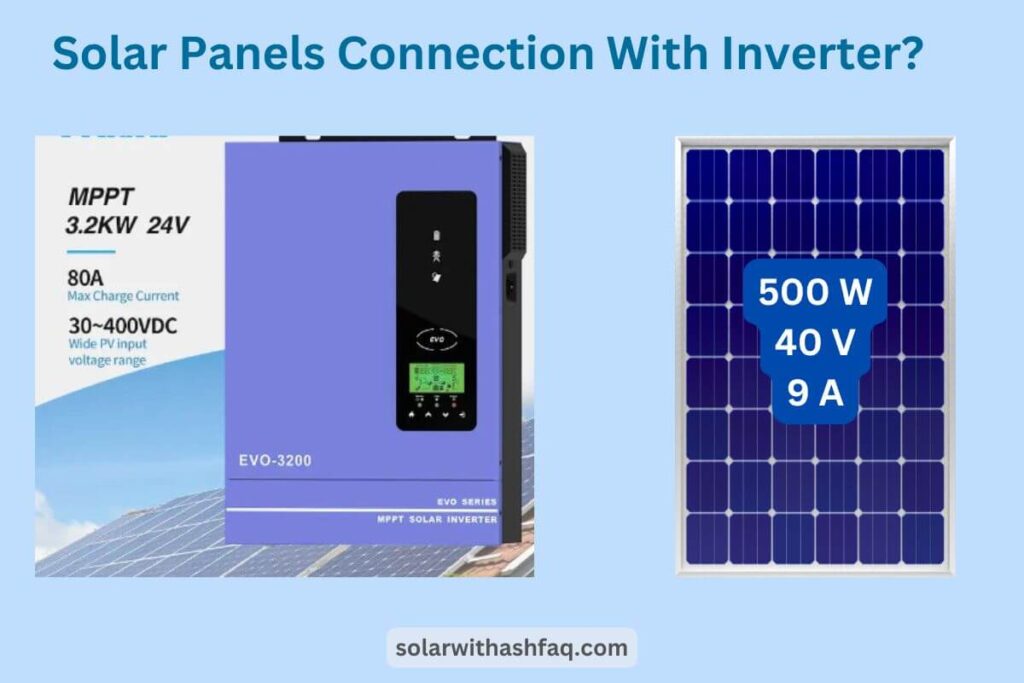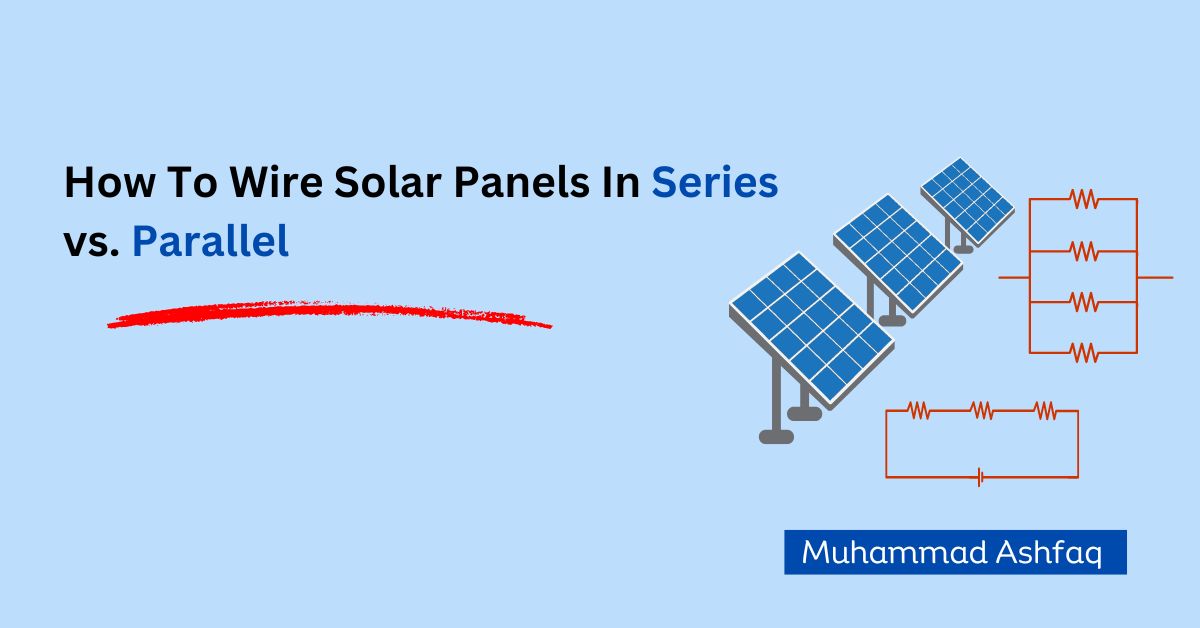How To Wire Solar Panels In Series vs. Parallel
Solar panels are two-terminal devices (like batteries), which means that they can be connected either in series or parallel.
In series, voltage gets added, while in parallel, currents are added.
Practically, solar installers use both wiring configurations to achieve the desired output voltage and current.
What goals do we achieve from both connections and which considerations do we have to keep in mind?
This blog post is all about the same.
Wiring Solar Panels in Series
When you wire solar panels in series, you connect the positive terminal of one panel to the negative terminal of the next panel.
This adds up the voltages of all the panels, but the current remains the same (equal to the current of a single panel)
Total Voltage = V1 + V2 ….. + Vn
I1 = I2 ….. = In

Series connection is useful when we have to match the voltages of panels with inverter input voltages limit (more detail later in this post).
Wiring Solar Panels in Parallel
In a parallel configuration, the positive terminals of all panels are connected together, and the negative terminals are connected together.
This adds up all the panels’ current, but the voltage stays the same as a single panel.
Total Current = I1 + I2 ….. + In
V1 = V2 ….. = Vn

This configuration helps us to match the overall panel current with the inverter input current limits.
Why are Solar Panels Wired in Series-Parallel Configuration?
If you happen to see an installed solar system, you might observe that solar panels are installed in both series and parallel combinations to form a string.
The concept is simple. You want to run a particular load with your inverter, which has a specified voltage and current limit (set by the manufacturer).
Similarly, solar panels also come with a certain voltage and current capacity.
You need to wire panels in such a way as to match the overall string voltage and current within the inverter input limits.
How Many Solar Panels Can You Connect to Your Inverter?
To better understand this, we discuss an example of how many panels are needed for a particular inverter.

Above is an on-grid inverter with a maximum DC voltage of 400V and maximum current of 80A, along with panel voltage and current ratings.
Here are the steps to determine the maximum number of panels that can be connected to this inverter.
Maximum Panels in Series
Find the inverter’s maximum DC voltage ratings
In this case, the inverter has a 400V maximum DC voltage and the panels are rated at 500W, 40V, 9A
Divide the inverter voltage rating by the panel’s rated voltage to get the maximum number of panels per series string.
Max. Panels Per Series String = 400V / 40V = 10 panels
It means you can add a maximum of 10 panels in series with this inverter.
Maximum Panels in Parallel
Find the inverter’s maximum current ratings
The inverter has a 80A maximum current rating and the panels are rated at 500W, 40V, 9A
Divide the inverter current rating by the panel’s rated current to get the maximum number of parallel strings.
Max Parallel Strings = 80A / 9A = 8 strings
So you can connect up to 8 panels in parallel to run the inverter within the safe conditions.
Remember!
Make sure that the total wattage of solar panels doesn’t exceed the solar inverter’s wattage; Otherwise, the inverter will saturate and clip the output to its maximum wattage.
Can You Add More Solar Panels to Your Existing System?
Yes, you can add more solar panels to your existing system.
But with one thing in mind—your inverter.
Check if connecting more panels exceeds the current and voltages of your existing inverter. If so, you need to upgrade to a larger inverter.
Systems with microinverters can avoid replacing the existing inverter, as they allow for easier expansion.
Popular Read: How Many Panels Required To Run 1.5 Ton AC?
What is the Disadvantage of Connecting Solar Panels in Parallel?
Parallel connections can have some repercussions, such as:
- Parallel connections increase the current, which requires thicker wires to handle the increased current.
- Parallel wiring is more complex, with each panel needing its own connection to the inverter or charge controller
What is the Disadvantage of Connecting Solar Panels in Series?
It also comes with some red flags, such as:
- If one panel in a series connection fails, it interrupts the entire circuit.
- When one panel in a series string is shaded, it can drastically reduce the power output of the entire string. This is because the current is limited by the weakest panel in the series.
Does the Wattage of Panels Increase in Series or Parallel?
When you connect solar panels in series or parallel, the overall wattage of the system does not change.
For example, if you connect four 300-watt panels in either series or parallel, the total energy produced will remain the same.
In this case 1200 watts (4 panels x 300 watts = 1200 watts).
Can I Connect Different Solar Panels Together?
Yes, you can connect different solar panels together, but it is not recommended.
When connected in series, the system will operate at the voltage of the lowest-rated panel.
So why do you want your system running at reduced voltage?
Similarly parallel, the total current will be limited by the panel with the lowest current rating.
How do Series/Parallel Solar Panels Handle High Temperatures?
I hope it doesn’t surprise you that high temperatures affect solar panels differently depending on whether they are connected in series or parallel.
But how is that?
Solar panels are rated for maximum efficiency at around 25°C (77°F), which is the standard condition under which manufacturers test and rate their panels.
In series connections, as the temperature rises, one or more panels overheat, decreasing the overall voltage output.
This is because the weakest panel limits the current, and any drop in voltage from one panel affects the entire series.
Conversely, in parallel connections, each panel operates independently. If one panel experiences high temperatures and its performance declines, the other panels can still produce power at their rated output.
However, higher temperatures can still reduce the efficiency of all panels, regardless of the connection method.
However, its effect is more predominant in series connections than parallel.
Wrapping Up
Wiring solar panels in series versus parallel has a notable impact on your system’s performance.
Understanding the limitations (and advantages) of each configuration helps you optimize your setup for your specific needs.
Frequently Asked Questions
Parallel generally allows for faster charging due to increased current output.
The total power output remains the same in both configurations; series increases voltage, while parallel increases current.
It depends on your system requirements. Use series for higher voltage and parallel for higher current.
The number of panels in a series is limited by the inverter’s maximum input voltage and the panels’ open-circuit voltage.
The best connection depends on your specific needs: series for higher voltage systems and parallel for higher current systems.

Content Writer | Assistant Manager (Electrical) at IESCO
As a passionate content writer, I’m on a mission to make solar hassle-free for you through my expert guides and easy-to-digest content.

